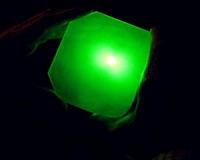| . |  |
. |
Ann Arbor, Mich. (UPI) Sep 3, 2010 A new laser technology could protect helicopters in combat from heat-seeking missiles, University of Michigan researchers say. Using inexpensive, off-the-shelf telecommunications fiber optics, Mohammed Islam, a professor in the UM Department of Electrical Engineering and Computer Science, has developed sturdy and portable "mid-infrared supercontinuum lasers" that could blind heat-seeking weapons from a distance of 1.8 miles, a university release said. "Battlefield terrain in places like Afghanistan and Iraq can be so rough that our troops have often had to rely on helicopters, and they can be easy targets for enemies with shoulder-launched missiles," Islam says. "Our lasers give off a signal that's like throwing sand in the eyes of the missile." The lasers are promising for helicopter protection because their robust, simple design can withstand the vibrations of helicopter flight. Most lasers emit light of just one wavelength. But supercontinuum lasers give off a focused beam packed with light from a much broader range of wavelengths. Islam's mid-infrared supercontinuum laser is the first to operate in longer infrared wavelengths that heat-seeking missiles use to home in on the infrared radiation that a helicopter engine emits. By emitting a broad spectrum of infrared light, it can effectively mimic the engine's electromagnetic signature and confuse any incoming weapons, Islam said.
Share This Article With Planet Earth
Related Links Learn about laser weapon technology at SpaceWar.com
 New System Developed To Test And Evaluate High-Energy Laser Weapons
New System Developed To Test And Evaluate High-Energy Laser WeaponsAtlanta GA (SPX) Aug 24, 2010 Technologies for using laser energy to destroy threats at a distance have been in development for many years. Today, these technologies known as directed energy weapons are maturing to the point of becoming deployable. High-energy lasers, one type of directed energy weapon, can be mounted on aircraft to deliver a large amount of energy to a far-away target at the speed of light, resulting ... read more |
|
| The content herein, unless otherwise known to be public domain, are Copyright 1995-2010 - SpaceDaily. AFP and UPI Wire Stories are copyright Agence France-Presse and United Press International. ESA Portal Reports are copyright European Space Agency. All NASA sourced material is public domain. Additional copyrights may apply in whole or part to other bona fide parties. Advertising does not imply endorsement,agreement or approval of any opinions, statements or information provided by SpaceDaily on any Web page published or hosted by SpaceDaily. Privacy Statement |